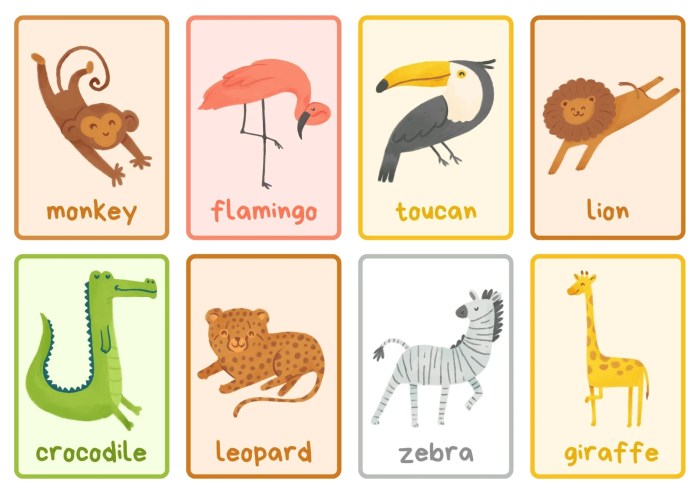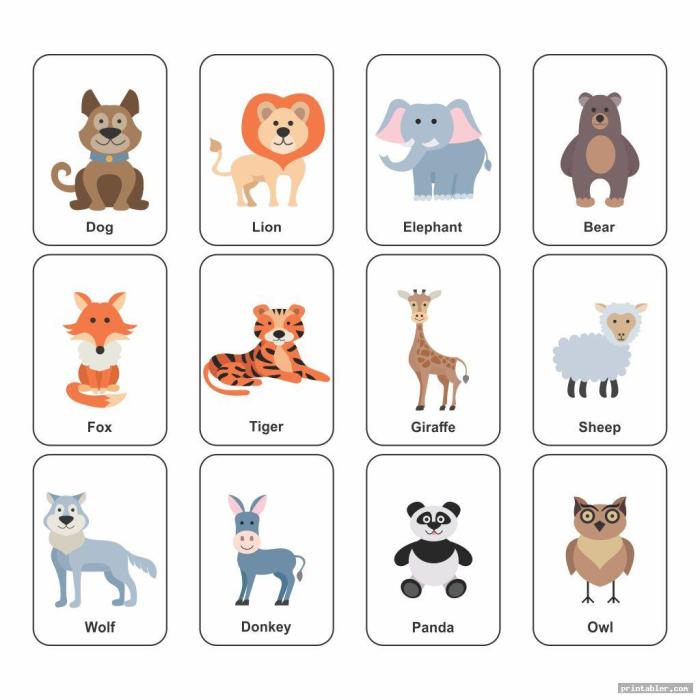Target Audience & Design Considerations

Creating effective animal coloring flash cards requires careful consideration of the target audience. Design choices, from image complexity to font selection, significantly impact a child’s engagement and learning experience. The following sections detail design considerations for preschool and elementary school children, highlighting key differences in visual and textual elements.
The fundamental principle is to tailor the design to the developmental stage of the child, ensuring the flash cards are both engaging and educationally beneficial.
Preschool Flash Card Design
Preschool flash cards should prioritize simplicity and visual appeal. Images should be large, bold, and depict single animals with easily recognizable features. The animal should occupy most of the card’s space, leaving ample room for coloring. Bright, primary colors should be used to stimulate visual interest. A clear, sans-serif font like Arial or Comic Sans, in a size of at least 24 points, should be used for the animal’s name.
The name should be placed prominently beneath the image, avoiding clutter. Consider using simple, age-appropriate vocabulary, focusing on the animal’s common name rather than scientific classification. The overall design should be uncluttered and visually stimulating.
Elementary School Flash Card Design
Flash cards for elementary school children can incorporate more complex designs and information. Images can show multiple animals in their habitats, or feature animals exhibiting characteristic behaviors. More detailed illustrations, including subtle textures and shading, are appropriate. The font size can be reduced to around 18 points, using a slightly more sophisticated sans-serif font like Calibri or Helvetica.
In addition to the common name, consider including a simple sentence describing a key feature or behavior of the animal, for example, “A lion has a mighty roar!” The layout should be well-organized, ensuring information is easily digestible. The use of subtle color palettes, beyond primary colors, can enhance the visual appeal and sophistication of the cards.
Toddler vs. Older Children: Design Comparison
The primary difference between flash cards for toddlers and older children lies in the level of visual and textual complexity. Toddlers benefit from large, simple images of single animals, using bold, primary colors and large, easy-to-read fonts. Older children can handle more detailed images, multiple animals per card, and more complex vocabulary and sentences. Font sizes can be smaller for older children, allowing for more text per card.
The layout for toddlers should be very simple and uncluttered, while older children can handle more complex layouts incorporating multiple elements. For example, a toddler’s flash card might show a single, brightly colored elephant, while an older child’s card could depict a family of elephants in their African habitat, with additional text describing their social structure.
Flash Card Layout Examples
The choice of layout significantly impacts the effectiveness of the flash cards. Several options exist, each catering to different learning styles and age groups.
Different layouts can cater to diverse learning styles and age groups. The following examples demonstrate this versatility.
- Single Animal Image: This classic layout features a large, central image of a single animal, with its name printed clearly underneath. This is ideal for younger children and focusing on individual animal recognition.
- Multiple Animals Per Card: This layout shows several animals from the same category (e.g., farm animals, jungle animals), allowing for comparison and categorization. This is more suitable for older children who can handle more information on a single card.
- Animal Habitats: This layout depicts an animal within its natural habitat, providing context and enriching the learning experience. It can include additional information about the animal’s environment and behavior, making it suitable for older children.
Animal Selection & Information

Creating engaging and informative flash cards requires careful consideration of the animals featured. The selection should encompass a diverse range of species, representing various habitats and showcasing distinctive characteristics easily recognizable by young children. The information provided alongside each animal should be concise, accurate, and age-appropriate.
Animal List by Habitat
The following list presents twenty common animals categorized by their natural habitats. This diverse selection aims to introduce children to a broad spectrum of the animal kingdom and their respective environments.
- Farm: Cow, Pig, Sheep, Chicken, Horse, Goat, Duck, Turkey
- Jungle: Monkey, Tiger, Elephant, Lion, Parrot, Snake, Jaguar, Toucan
- Ocean: Dolphin, Whale, Shark, Seal, Octopus, Crab, Starfish, Sea Turtle
Key Features of Selected Animals
This section details key visual characteristics of five animals, focusing on aspects easily replicated in illustrations for flash cards. Clear and simple illustrations are crucial for effective learning.
- Lion: Mane (males), muscular body, tawny color, sharp claws and teeth. Illustrate a lion in a dynamic pose, perhaps roaring, to capture its powerful nature.
- Elephant: Large ears, long trunk, tusks (some males and females), wrinkled grey skin, thick legs. Show the elephant’s size by including a smaller element for scale in the illustration.
- Giraffe: Long neck, long legs, spotted coat (pattern varies), dark eyes. The illustration should emphasize the giraffe’s height and unique markings.
- Penguin: Flightless bird, black and white plumage, flippers, waddle. The illustration should highlight the penguin’s upright posture and distinctive coloring.
- Dolphin: Streamlined body, grey skin, dorsal fin, pointed snout. The illustration should capture the dolphin’s sleek shape and playful nature, perhaps mid-leap.
Endangered Animal List
The following table showcases ten endangered animals, highlighting their habitats, key features, and conservation status. Raising awareness about endangered species is an important educational aspect of these flash cards.
| Animal Name | Habitat | Key Features | Conservation Status |
|---|---|---|---|
| Amur Leopard | Russian Far East | Spotted coat, powerful build | Critically Endangered |
| Giant Panda | China | Black and white fur, round body | Vulnerable |
| African Elephant | Africa | Large size, long trunk, tusks | Endangered |
| Sumatran Orangutan | Sumatra, Indonesia | Long arms, reddish-orange fur | Critically Endangered |
| Snow Leopard | Himalayan Mountains | Thick fur, spotted coat, long tail | Vulnerable |
| Black Rhinoceros | Africa | Two horns, thick skin | Critically Endangered |
| Sea Turtle | Oceans worldwide | Shell, flippers | Endangered (varies by species) |
| Tiger | Asia | Striped coat, powerful build | Endangered |
| Gorilla | Africa | Large size, powerful build, black fur | Endangered |
| Polar Bear | Arctic | Thick fur, large size, powerful paws | Vulnerable |
Polar Bear Flash Card Design
This flash card will feature a polar bear in its Arctic habitat. The illustration will depict a polar bear standing on an ice floe, possibly fishing or looking out over the icy landscape.The color palette will be predominantly white, with varying shades of blue and grey for the ice and water. The polar bear’s fur will be a creamy white, with subtle variations in shading to create depth and texture.
Animal coloring flash cards are a fun way to learn about different creatures. To deepen understanding of animal biology, you might also consider using a worksheet focusing on the inner workings of cells; a great resource is this animal and plant cells coloring worksheet. After completing the worksheet, returning to the flash cards can reinforce learned concepts and provide a visual comparison between macroscopic animal features and their microscopic cellular structures.
Key features to highlight include the bear’s thick fur, large paws, and sharp claws. The text will describe the polar bear’s habitat (Arctic ice), diet (seals, fish), and unique adaptations (thick blubber for insulation, powerful swimming abilities).
Educational Value & Activities: Animal Coloring Flash Cards

Animal flash cards offer a versatile and engaging tool for early childhood education, fostering cognitive development and a love for the natural world. They provide a hands-on approach to learning, making abstract concepts like animal names and habitats more concrete and memorable for young children.These cards can be effectively utilized to teach a variety of skills, moving beyond simple memorization.
They provide opportunities for language development, memory enhancement, and even the introduction of basic scientific concepts related to animal classification and ecosystems.
Teaching Animal Names, Sounds, and Habitats, Animal coloring flash cards
Flash cards featuring vibrant images of animals can be used to introduce children to the names of various species. The visual aid paired with verbal repetition helps solidify the connection between the image and the word. Furthermore, incorporating animal sounds – either through imitation or recordings – adds another sensory dimension to the learning process, strengthening memory and comprehension.
Finally, each card can include a brief description of the animal’s natural habitat, helping children understand where different animals live and the environments they inhabit. For example, a card featuring a polar bear could include the word “polar bear,” a recording or imitation of a bear’s growl, and a short description like “lives in the Arctic.”
Interactive Games Using Flash Cards
Several interactive games can enhance learning and engagement. Memory matching involves laying the cards face down and having children flip them over two at a time, searching for matching pairs. This game improves memory and concentration skills. Animal Bingo can be created using custom bingo cards featuring animal images, and calling out the animal names. This encourages listening skills and reinforces recognition of the animals.
Lesson Plan for Preschoolers (30 Minutes)
This lesson plan Artikels a 30-minute activity using animal flash cards for preschoolers.
- Introduction (5 minutes): Begin by showing the flash cards one by one, naming each animal clearly and making its sound. Encourage children to repeat the names and sounds.
- Memory Matching (10 minutes): Shuffle the cards and play a memory matching game. Start with a smaller number of cards and gradually increase the difficulty as children improve.
- Habitat Discussion (5 minutes): Choose a few cards and discuss where each animal lives, using simple language and visuals. For instance, show a picture of a giraffe and explain that it lives in Africa.
- Animal Bingo (5 minutes): Play a simplified version of Animal Bingo with a few cards. Call out the animal names and have children mark them on their bingo cards.
- Wrap-up (5 minutes): Review the animal names and sounds learned during the session. Encourage children to share their favorite animal and why.
Vocabulary Development and Memory Skill Enhancement
Utilizing flash cards effectively boosts vocabulary by repeatedly exposing children to new words in a visually engaging way. The process of associating images with words strengthens memory retention. Regular use of flash cards, coupled with interactive games, strengthens memory skills and improves cognitive function. The repetition inherent in using flash cards helps to embed the new vocabulary and concepts into long-term memory.
For instance, repeated exposure to the word “hippopotamus” alongside its image will improve a child’s ability to recall and use the word in the future.
Q&A
How durable are the flash cards?
The durability depends on the paper stock used. Thicker cardstock is recommended for increased longevity.
Can these flash cards be laminated?
Yes, laminating the flash cards will significantly increase their durability and make them washable.
Are the animals depicted realistically or cartoonishly?
The style can be adapted. Options range from realistic depictions to more stylized, cartoonish versions, depending on the target age group.
What is the best way to store the flash cards?
A sturdy storage box or binder with sleeves is recommended to keep the cards organized and protected.










